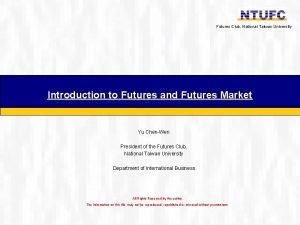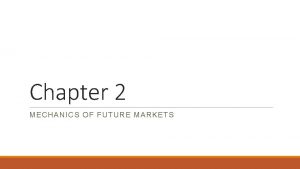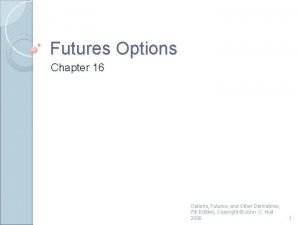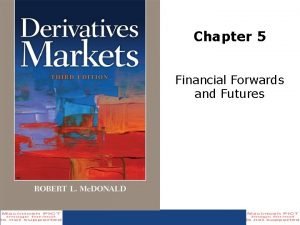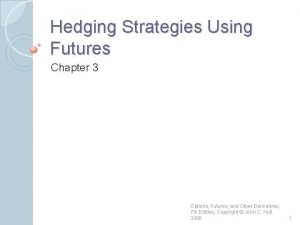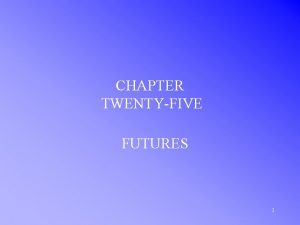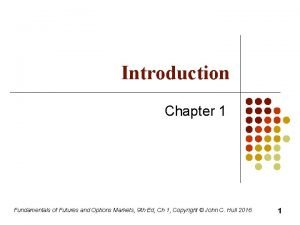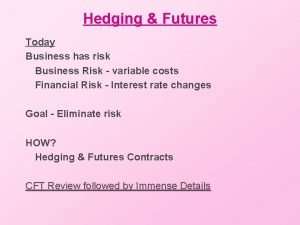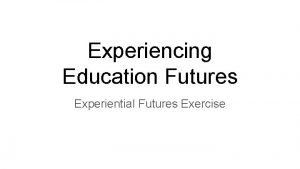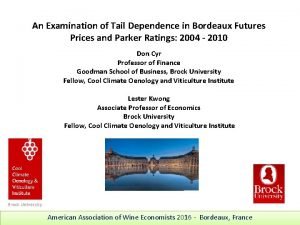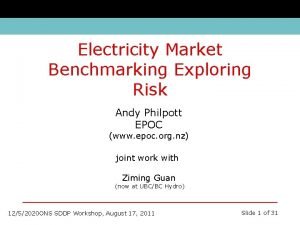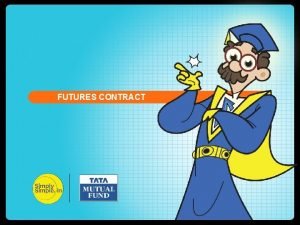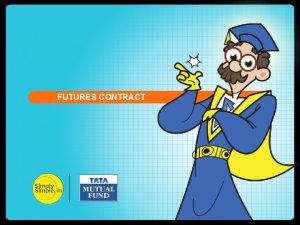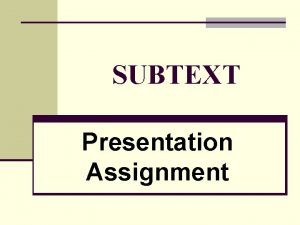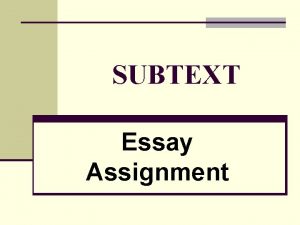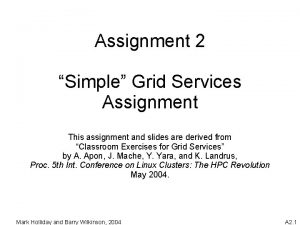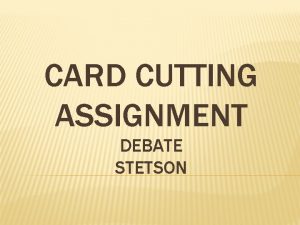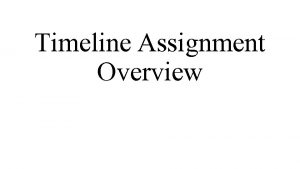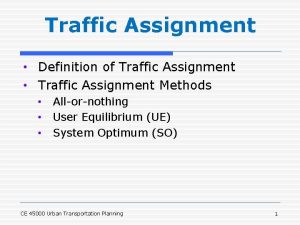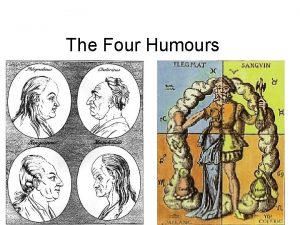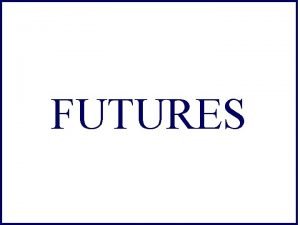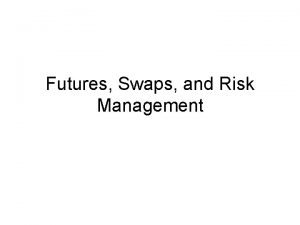Four Futures Assignment Four Futures Four Futures refers

















- Slides: 17

Four Futures – Assignment Four Futures

Four Futures refers to a set of scenario archetypes: Continued Growth, Disciplined/Constrained, Transformed, and Decline Collapse. The original model was developed and popularized by Foresight Professor Jim Dator at the University of Hawaii. While the framework has been used for years in the foresight community it was most recently codified in the Journal of Futures Studies November 2009.

The Assignment We would like you to draft notes on your organization’s Four Futures for the 2020 s 2030 s time horizon. Please complete ‘bullet point’ drafts for all four futures based on the template on subsequent pages. Feel free to adjust the dates (though my preference is to show a ‘step by step’ story rather than a snapshot of your organization. As you create your bullet points please try to integrate changes in the Green Bay region as well as your organization.

Four Futures Thinking ? Continued Growth 2008 – 2014 Disciplined Constrained Transformed Decline Collapse

Task: Construct Your Futures Continued Growth Disciplined Constrained Transformed Decline Collapse

Storytelling Tips Experiment with Story Structures q Multi-paragraph stories q Bullet points of storyline elements q Visualizations that communication the message STEEP Forces of Change Each scenario should include elements of the STEEP categories of change: q Society (Demographics / Culture) q Technology q Economy q Environment q Politics (Legal) Three Mechanisms of Change Your scenarios should include: 1) Trends Slow moving changes over time; Language should be ‘more’ or ‘less’ 2) Events Sources of discontinuity including: Scheduled Events Plausible Events Wildcard Events (Low Probability, High Impact) 3) Choices Reflect our investments in people, partnerships and places.

Continuation: Template Draft Name of Continuation Scenario The Continuation Story q In 2021… q In 2023… q In 2025… q In 2029… q In 2030… q In 2035… Evidence: Signals to Support this Scenario q Signal Title/Link 7

Continuation ? Continuation is story based on signals that reflect knowns and extrapolation of generally positive forces. This scenario may be viewed as the ‘baseline’ (extrapolation) or ‘official future’ which reflect the shared (often unspoken) assumptions of an organization. When you create the Continuation story it should include q. Familiar stakeholders and partnerships q. Policies, services & value offerings, and customer (citizen) needs q. How you overcame new twists & turns along the way The story should include challenges of new social norms and market dynamics but inevitably reveal how your organization leverages its core capabilities and ‘rides the wave’ of change. 8

Disciplined / Constrained Disciplined/Constrained is a story of the future where your organization continues to operate in a traditional manner despite evidence that the world around you has shifted. Key organizational challenges are maintaining relevance and returning to growth. 2008 – 2014 When you create the Disciplined/Constrained story be sure to reveal: q Signals that suggest your current services and value offerings are less relevant or aligned to market and client needs. q Signals that challenge organizational culture or processes. The story might surface how the organization’s inability or refusal to change has hit a ‘limits to growth’ phase. The story’s tone is not fatalistic but morale and expectations for growth are muted. You will survive but not thrive.

Disciplined / Constrained: Template Draft Name of Disciplined / Constrained Scenario The Disciplined-Constrained Story q In 2021… q In 2023… q In 2025… q In 2029… q In 2030… q In 2035… Evidence: Signals to Support this Scenario q Signal Title/Link 10

Transformed is a scenario archetype where the world and organization have gone through an era-step change. Think caterpillar to butterfly – or Industrial to Information Economy. The story should reveal how the organization (region) became something different. This may be the emergence of a new department or team. Or it might be a wholesale reinvention of the entire organization culture or value proposition. The story tone is not utopian. There should be new problems and challenges that appear as expected – or as unintended consequences. Leave some issues unresolved. The key story dynamic should show the organization is empowered and feels in control of its future in this new world.

Transformed: Template Draft Name of Transformed Scenario The Transformed Story q In 2021… q In 2023… q In 2025… q In 2029… q In 2030… q In 2035… Evidence: Signals to Support this Scenario q Signal Title/Link

Decline / Collapse Decline/Collapse is a scenario archetype where the world has changed and your company has not. The Collapse Story connects signals that suggest: q Your imminent demise (e. g. Shut down firm; Merger) q An End of Growth (A Burning Platform) q Stagnation is challenging your culture When you create the Decline/Collapse story be sure to describe both external conditions (outside-in changes) and internal actions (inside-out changes). You might also emphasize inactions or decisions not made. The story may describe innovative efforts that failed and did not succeed as you attempted to transform the organization.

Decline Collapse: Template Draft Name of Decline/Collapse Scenario The Decline-Collapse Story q In 2021… q In 2023… q In 2025… q In 2029… q In 2030… q In 2035… Evidence: Signals to Support this Scenario q Signal Title/Link

Resource: Team Conversations When the Four Futures are written, you should engage colleagues in answering strategic questions: q What signals or trends have you seen that might support the future described in each scenario? q What are the internal implications for our partners and teams? What might our customers (citizens) do differently to thrive in this future? q Where might the story go from here? Write a few extensions from this future. q What indicators or milestones might we monitor that represent a tipping point of this future?

Examples: Four Futures

 Futures club
Futures club Mechanics of futures market
Mechanics of futures market Futures style options
Futures style options Euro stoxx 50 index dividend futures
Euro stoxx 50 index dividend futures Futures and forwards
Futures and forwards Interest rate futures
Interest rate futures Hedging strategies using futures
Hedging strategies using futures Bright future scholarship
Bright future scholarship Mechanics of futures market
Mechanics of futures market Futures definition
Futures definition Introduction to futures and options
Introduction to futures and options Bright futures screening guidelines
Bright futures screening guidelines Futures for you
Futures for you Blue chip derivatives
Blue chip derivatives Experiential futures ladder
Experiential futures ladder Cheapest to deliver bond
Cheapest to deliver bond Futures bordeaux wijnen
Futures bordeaux wijnen Futures market
Futures market
